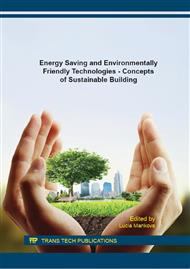[1]
A.F. Speak, J.J. Rothwell, S.J. Lindleya, C.L. Smith, Rainwater runoff retention on an aged intensive green roof, Science of The Total Environment, Elsevier BV, Amsterdam, 2013, volumes 461-462, pp.28-38.
DOI: 10.1016/j.scitotenv.2013.04.085
Google Scholar
[2]
K. Vijayaraghavan, Franklin D. Raja, Design and development of green roof substrate to improve runoff water quality: Plant growth experiments and adsorption, Water Research, Elsevier BV, Amsterdam, 2014, volume 63, pp.94-101.
DOI: 10.1016/j.watres.2014.06.012
Google Scholar
[3]
P. -A. Versini, D. Ramier, E. Berthier, B. de Gouvello, Assessment of the hydrological impacts of green roof: From building scale to basin scale, Journal of Hydrology, Volume 524, May 2015, Pages 562-575, ISSN 0022-1694.
DOI: 10.1016/j.jhydrol.2015.03.020
Google Scholar
[4]
FLL (2008). Guidelines for the Planning, Construction and Maintenance of Green Roofing. Forschungsgesellschaft Landschaftsentwicklung Landschaftsbau e.V. (FLL), Bonn.
DOI: 10.51202/9783816798118-559
Google Scholar
[5]
Chloe J. Molineux, Alan C. Gange, Stuart P. Connop, Darryl J. Newport, Using recycled aggregates in green roof substrates for plant diversity, Ecological Engineering, Volume 82, September 2015, Pages 596-604, ISSN 0925-8574.
DOI: 10.1016/j.ecoleng.2015.05.036
Google Scholar
[6]
ČSN 73 0540-3, Thermal protection of buildings - Part 3: Design value quantities, Czech Office for Standards, Metrology and Testing, Prague, (2005).
Google Scholar
[7]
ČSN EN ISO 6946, Building components and building elements - Thermal resistance and thermal transmittance - Calculation method, Czech Office for Standards, Metrology and Testing, Prague, (2008).
DOI: 10.3403/30127651
Google Scholar
[8]
ČSN EN ISO 10456, Building materials and products - Hygrothermal properties - Tabulated design values and procedures for determining declared and design thermal values, Czech Office for Standards, Metrology and Testing, Prague, (2009).
DOI: 10.3403/30134452
Google Scholar
[9]
Information on http: /www. passivehouse-international. org/index. php?page_id=80.
Google Scholar
[10]
ETAG 031 - part 1, Guideline for European technical approval od Inverted Roof Insulation Kits, Brussels, (2010).
Google Scholar
[11]
DIBt (2013). European Technical Approval: Kits for Green Roofs (ETA-13/0668). Deutsches Institut für Bautechnik (DIBt), Berlin.
Google Scholar
[12]
J. Czemiel Berndtsson. Green roof performance towards management of runoff water quantity and quality. Ecol Eng 36 (2010), pp.351-360.
DOI: 10.1016/j.ecoleng.2009.12.014
Google Scholar
[13]
C. Lamera, G. Becciu, M.C. Rulli et al. Green Roofs Effects on the Urban Water Cycle Components. Procedia Eng. 70 (2014), pp.988-997.
DOI: 10.1016/j.proeng.2014.02.110
Google Scholar
[14]
M. Zhao et al. Effects of plant and substrate selection on thermal performance of green roofs during the summer. Build Environ. 78 (2014), pp.199-211.
Google Scholar
[15]
P. Vacek, L. Matějka. Usage of Hydrophilic Mineral Wool Panels in Green Roof Systems in Passive Houses. Advanced Materials Research 1041 (2014), pp.75-78.
DOI: 10.4028/www.scientific.net/amr.1041.75
Google Scholar
[16]
D.J. Sailor, M. Hagos, An updated and expanded set of thermal property data for green roof growing media, Energy and Buildings, Elsevier BV, Amsterdam, Volume 43, Issue 9, 2011, pp.2298-2303.
DOI: 10.1016/j.enbuild.2011.05.014
Google Scholar
[17]
Štajer, S., Systémový návrh a realizace inverzních plochých střech s drenážně separační fólií, available on http: /building. dow. com/europe/cz/pdf/291-40219. pdf.
Google Scholar
[18]
CSI a. s. (2014). Protokol o zkoušce č. P 492-12/14: Stanovení schopnosti pro proudění vody v rovině desky pro materiály OH76 a OH120. Centrum stavebního inženýrství, a. s., Praha.
Google Scholar
[19]
M. B. Kirkham (2014), Principles of Soil and Plant Water Relations. Academic Press, Boston.
Google Scholar
[20]
CSI A.S. Protokol o zkoušce č. 2253: Stanovení součinitele tepelné vodivosti a vodopropustnosti hydrofilního výrobku Cultilene z minerálních vláken s objemovou hmotností 76 kg/m3 a 120 kg/m3. Praha, (2014).
Google Scholar
[21]
ČSN 73 0540-4, Thermal protection of buildings - Part 4: Calculation methods, Czech Office for Standards, Metrology and Testing, Prague, (2005).
Google Scholar
[22]
Information on http: /cs. wikipedia. org/wiki/Geografie_%C4%8Ceska.
Google Scholar
[23]
Optigreen, Drainage Material Type Perl 2/10 BS, Information on www. optigreen. de.
Google Scholar
[24]
Optigreen, Intensive Substrate Type I, Information on www. optigreen. de.
Google Scholar
[25]
Optigreen, Intensive/Extensive Single Layer Substrate Type Optilith (RO), Information on www. optigreen. de.
Google Scholar
[26]
Pakkala, T. A., Long-term water absorption tests for frost insulation materials taking into account frost attack, Case Studies in Construction Materials, Elsevier BV, Amsterdam, 2014, volume 1, pages 40-45.
DOI: 10.1016/j.cscm.2014.02.001
Google Scholar
[27]
ČSN EN 13164, hermal insulation products for buildings - Factory made products of extruded polystyrene foam (XPS) - Specification, Czech Office for Standards, Metrology and Testing, Prague, (2002).
DOI: 10.3403/30213966
Google Scholar


